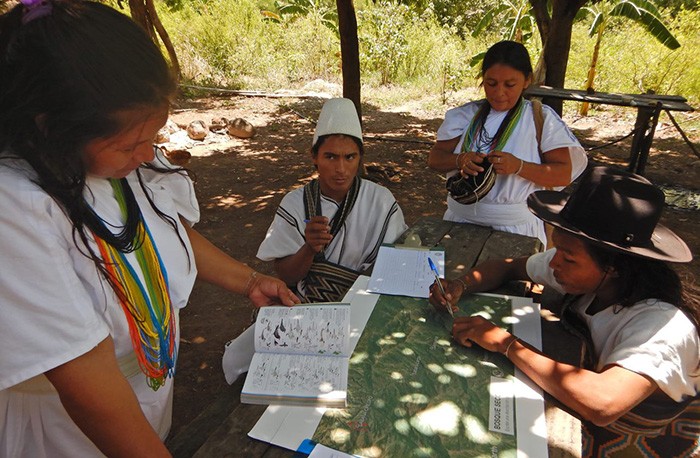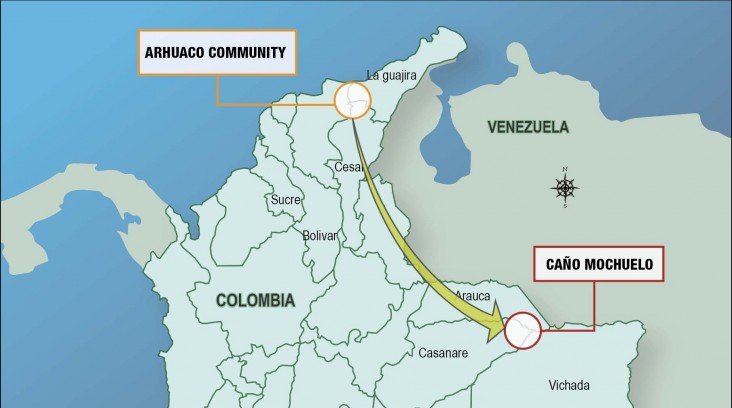Speeches Shim

September 11, 2020
From the world’s highest coastal mountain and Colombia’s vast savannahs, USAID’s Natural Wealth Program brought two indigenous communities together for the first time to discuss the recovery of indigenous knowledge and approaches to territorial governance in favor of biodiversity conservation. This intercultural encounter kickstarted a compelling conversation on the nexus of nature and culture between the Arhuaco peoples from the Sierra Nevada de Santa Marta and the ten ethnic groups in Caño Mochuelo’s indigenous territory in the Casanare Department.

The Arhuacos have exercised effective management of their sociopolitical structure, are committed to protecting their territory, and have been able to strengthen their cultural traditions. They have inhabited the dry tropical forest over the years using successful practices to conserve the surrounding ecosystem. In stark contrast, the communities in Caño Mochuelo’s Indigenous Reserve have lost a great amount of their territory and suffered persecution by nonindigenous groups, forcing them to leave behind their nomadic livelihoods to settle on a sole piece of land. As a result, Caño Mochuelo’s ten ethnic groups now share a single territory in this flooded savannah habitat and their cultural identity and traditions are greatly threatened.
These indigenous partnerships strengthen our common goal for territorial assertion and conservation. Each indigenous nation is determined by their territory—the water, the forest, the animals—and these natural characteristics allow us to develop and thrive.” —Rogelio Torres, Arhuaco Territorial Coordinator
The Natural Wealth project pioneered this cross-cultural dialogue to highlight the importance of empowering indigenous groups in governance, safeguarding indigenous cultures, and creating more resilient communities in consideration of good natural resource management and biodiversity conservation. Learning from other cultures, and particularly from the Arhuacos, is timely for the Caño Mochuelo peoples as the implications of losing their cultural identity and traditions are becoming more prominent, a reality that is inextricably linked to the shift away from a nomadic lifestyle.
USAID Colombia celebrates the 2020 International Day of the World's Indigenous Peoples.
The Arhuaco delegation and the Natural Wealth Program team traveled to Caño Mochuelo, where they were greeted by more than 200 indigenous women, youngsters, and ancestral and political authorities. The intercultural exchange presented a snapshot of the Arhuaco’s long history of strong territorial governance with the purpose to provide the Caño Mochuelo communities with tools to build their own territorial vision. These tools include fostering the elders’ participation in decision making to recover traditional knowledge, a step the Arhuacos believe is essential for territorial protection and land conservation efforts in modern times. This exchange was a stepping stone for future encounters, as the Arhuaco delegation invited Caño Mochuelo leaders to visit their territory in the Sierra Nevada de Santa Marta. Natural Wealth will continue to support and work with the Caño Mochuelo communities by promoting an intergenerational dialogue within all ten ethnicities and by facilitating future exchanges with the Arhuaco peoples.
“It was very important to learn from the Arhuaco community that territorial processes are long-term endeavors. We have to recover our ancestral knowledge which provides the vision and the autonomy to keep our culture, livelihoods, and territory alive.” —Augustín Rodriguez, Caño Mochuelo Territorial Coordinator
Connecting indigenous communities through this first exchange opened the door to a new partnership built on trust. This innovative approach will facilitate dialogue between Arhuacos and the Caño Mochuelo Indigenous Council to strengthen their governance and protection of natural resources. USAID’s Natural Wealth Program aims to benefit the livelihoods of more than 4,500 people from both indigenous territories in 110,000 hectares of dry tropical forest and flooded savannah ecosystems.
This story originally appeared in the Natural Wealth project newsletter. Learn more about biodiversity conservation programming in Colombia.

Comment
Make a general inquiry or suggest an improvement.